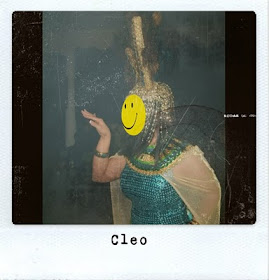As this year comes to a close I wanted to watch another classic movie, and although I am not planning a New Year's Eve for two, I did want to watch the crazy shenanigans of Norma Desmond in Sunset Blvd. (Paramount Pictures, 1950). The film stars Gloria Swanson as Norma Desmond, a washed up silent film star, and William Holden as unsuccessful writer, Joe Gillis. At first Joe is only helping Norma with her crazy, lofty, and nonsensical script - a script that Norma believes will mark her return to the pictures. But it soon becomes apparent that Norma has fallen in love with Joe and she lavishes him with jewelery, fine clothes, and that infamous New Year's Eve party for two. As Joe gets wrapped up in Norma's illusions of re-gaining her fame, he also realizes that she is crazier than anyone thinks, and he has also fallen in love with his friend Betty Schaefer, who is an aspiring writer who reads scripts at Paramount. Norma gets wind of this and an argument ensues. I won't give the whole movie away, but I will say that the film deserves all of the accolades it has garnered over the years. From the casting to the costumes, writing, and cinematography, Sunset Blvd. is a must-see film. Gloria Swanson's performance is riveting, and the whole picture is just really creepy and foreboding, but also kind of seductive and fascinating. A great way to spend an evening in.
 |
| Photo by toestubber from Flickr Creative Commons |
Here is some trivia on the film and I hope that the new year is filled with bright stars, big pictures, and not too many close-ups.
- In 2007 Sunset Blvd. was listed on their 10th anniversary list as the 16th best American film of the 20th century by the American Film Institute.
- Right before William Holden came on board to play Joe Gillis, Montgomery Clift was signed to do the role for $5,000 dollars a week.
- The shot of Gillis dead in the pool was achieved using mirrors at the bottom of the pool and shooting from above.
- There are several cameos in the film, including Hedda Hopper, Cecil B. DeMille, and Buster Keaton.
- Norma Talmadge may have been the inspiration for the character of Norma Desmond, and for the character of Lina Lamont in Singin' in the Rain (Metro-Goldwyn-Mayer, 1952)
- The swan bed that Norma Desmond sleeps in for the film was first used in the film The Phantom of the Opera (Universal Studios, 1925)
- Norma Desmond's home in the movie was an actual house belonging to the former wife of J. Paul Getty. It was used five years later in the film Rebel Without a Cause (Warner Bros., 1955). Unfortunately it was torn down just 2 years later in 1957.
- The line "All right, Mr. DeMille, I'm ready for my close-up" was ranked the no. 7 movie quote out of 100 by the American Film Institute.
- William Holden celebrated his 31st birthday during filming, and Gloria Swanson celebrated her 50th.
- The film got 11 Oscar nominations, it won 3, but it did not get Best Picture. All About Eve (Twentieth Century Fox, 1950) won for Best Picture that year.
- While the movie was in production it was code-named "A can of beans" because of how Hollywood was being portrayed and the fear of a bad reaction.
 |
| Gloria Swanson as Norma Desmond Photo by cirne from Flickr Creative Commons |




































